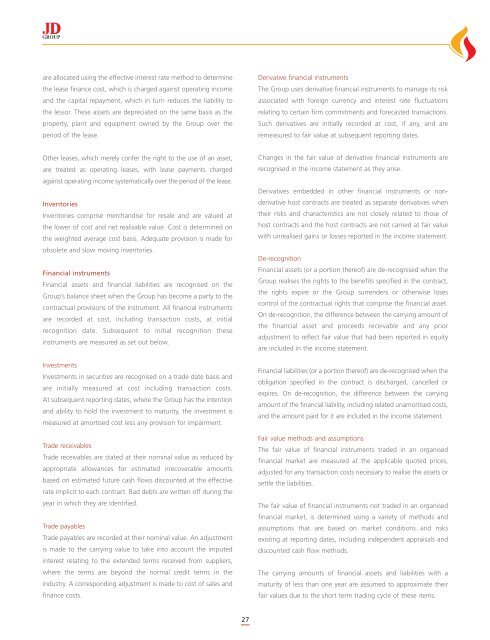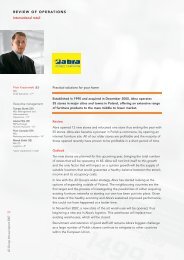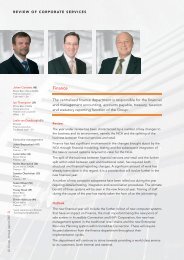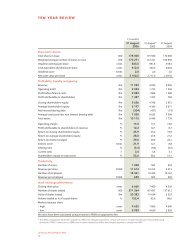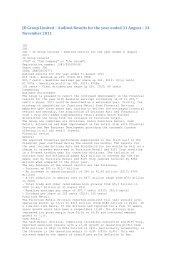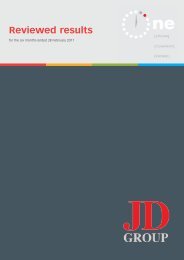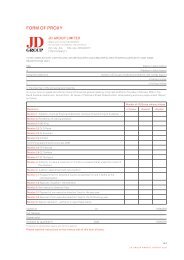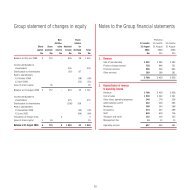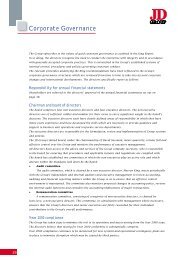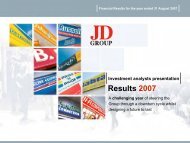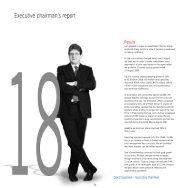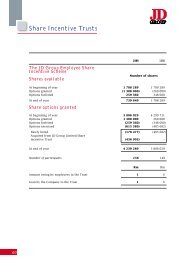Annual Report - JD Group
Annual Report - JD Group
Annual Report - JD Group
You also want an ePaper? Increase the reach of your titles
YUMPU automatically turns print PDFs into web optimized ePapers that Google loves.
are allocated using the effective interest rate method to determine<br />
the lease finance cost, which is charged against operating income<br />
and the capital repayment, which in turn reduces the liability to<br />
the lessor. These assets are depreciated on the same basis as the<br />
property, plant and equipment owned by the <strong>Group</strong> over the<br />
period of the lease.<br />
Other leases, which merely confer the right to the use of an asset,<br />
are treated as operating leases, with lease payments charged<br />
against operating income systematically over the period of the lease.<br />
Inventories<br />
Inventories comprise merchandise for resale and are valued at<br />
the lower of cost and net realisable value. Cost is determined on<br />
the weighted average cost basis. Adequate provision is made for<br />
obsolete and slow moving inventories.<br />
Financial instruments<br />
Financial assets and financial liabilities are recognised on the<br />
<strong>Group</strong>’s balance sheet when the <strong>Group</strong> has become a party to the<br />
contractual provisions of the instrument. All financial instruments<br />
are recorded at cost, including transaction costs, at initial<br />
recognition date. Subsequent to initial recognition these<br />
instruments are measured as set out below.<br />
Investments<br />
Investments in securities are recognised on a trade date basis and<br />
are initially measured at cost including transaction costs.<br />
At subsequent reporting dates, where the <strong>Group</strong> has the intention<br />
and ability to hold the investment to maturity, the investment is<br />
measured at amortised cost less any provision for impairment.<br />
Trade receivables<br />
Trade receivables are stated at their nominal value as reduced by<br />
appropriate allowances for estimated irrecoverable amounts<br />
based on estimated future cash flows discounted at the effective<br />
rate implicit to each contract. Bad debts are written off during the<br />
year in which they are identified.<br />
Trade payables<br />
Trade payables are recorded at their nominal value. An adjustment<br />
is made to the carrying value to take into account the imputed<br />
interest relating to the extended terms received from suppliers,<br />
where the terms are beyond the normal credit terms in the<br />
industry. A corresponding adjustment is made to cost of sales and<br />
finance costs.<br />
27<br />
Derivative financial instruments<br />
The <strong>Group</strong> uses derivative financial instruments to manage its risk<br />
associated with foreign currency and interest rate fluctuations<br />
relating to certain firm commitments and forecasted transactions.<br />
Such derivatives are initially recorded at cost, if any, and are<br />
remeasured to fair value at subsequent reporting dates.<br />
Changes in the fair value of derivative financial instruments are<br />
recognised in the income statement as they arise.<br />
Derivatives embedded in other financial instruments or nonderivative<br />
host contracts are treated as separate derivatives when<br />
their risks and characteristics are not closely related to those of<br />
host contracts and the host contracts are not carried at fair value<br />
with unrealised gains or losses reported in the income statement.<br />
De-recognition<br />
Financial assets (or a portion thereof) are de-recognised when the<br />
<strong>Group</strong> realises the rights to the benefits specified in the contract,<br />
the rights expire or the <strong>Group</strong> surrenders or otherwise loses<br />
control of the contractual rights that comprise the financial asset.<br />
On de-recognition, the difference between the carrying amount of<br />
the financial asset and proceeds receivable and any prior<br />
adjustment to reflect fair value that had been reported in equity<br />
are included in the income statement.<br />
Financial liabilities (or a portion thereof) are de-recognised when the<br />
obligation specified in the contract is discharged, cancelled or<br />
expires. On de-recognition, the difference between the carrying<br />
amount of the financial liability, including related unamortised costs,<br />
and the amount paid for it are included in the income statement.<br />
Fair value methods and assumptions<br />
The fair value of financial instruments traded in an organised<br />
financial market are measured at the applicable quoted prices,<br />
adjusted for any transaction costs necessary to realise the assets or<br />
settle the liabilities.<br />
The fair value of financial instruments not traded in an organised<br />
financial market, is determined using a variety of methods and<br />
assumptions that are based on market conditions and risks<br />
existing at reporting dates, including independent appraisals and<br />
discounted cash flow methods.<br />
The carrying amounts of financial assets and liabilities with a<br />
maturity of less than one year are assumed to approximate their<br />
fair values due to the short term trading cycle of these items.


